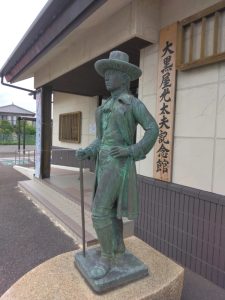
November 1st is black tea day in Japan.
While Japanese green tea has a long tradition, black tea was for the most part unknown in Japan’s history.
Let’s remember that during the sakoku period (1603 to 1868), Japan was closed to the world.
Foreigners were not allowed to enter Japan, while Japanese people were prohibited from leaving the country.
Nevertheless, historical records show that in 1791, a Japanese person had an audience with Russian empress Catherine the Great.
This person was Daikokuya Kōdayū (大黒屋 光太夫).
Early life of Daikokuya Kōdayū
He was born in 1751 in what is now Suzuka city of Mie prefecture.
His father was a wealthy merchant, but he passed away when Kōdayū was a child.
He was then adopted by relatives and moved to Edo.
His long and harsh adventure begins
Eventually, he became the captain of the family’s merchant boat named Shinshōmaru (神昌丸).
In 1782, Kōdayū set sail from Shiroko port in Mie prefecture along with 16 sailors. Their destination was Edo.
Unfortunately, a storm damaged the ship and it drifted for 7 months.
One sailor died during that difficult time, but at least they arrived to Amchitka island.
The island now belongs to the US, but at that time it was part of Russia.
Kōdayū and his crew were greeted by Russians and native Aleut people that lived there.
The ship was badly damaged by then. It became unusable.
So they had no choice but to wait for a Russian ship to come.
The island’s climate was so cold that 6 more sailors died.
And to make matters worse, when the Russian ship was arriving 2 years later, it was destroyed by another storm.
Kōdayū, who could now speak some Russian, decided to build another ship.
By the time they finally sailed out of the island with the 25 Russians that were also stranded, another 2 years had passed.
Although Kōdayū and his 9 sailors wanted to return to Japan, the Russians had orders to travel to Irkutsk.
After one and a half months of sailing during a cold winter and on the verge of starvation, they managed to arrive to Kamchatka.
Sadly, 3 Japanese sailors perished.
After reaching the mainland, the next phase of the journey was traveled by horse.
The temperature was sometimes as low as -50ºC (-58ºCF).
One sailor lost his foot as a result.
Kōdayū and his 6 remaining sailors finally reached Irkutsk in 1789. 7 years after they had sailed from Mie prefecture.
But instead of helping him to go home, the Russian authorities ordered him to stay and become a Japanese teacher.
Russia wanted to have a way to approach Japan for trade.
The light at the end of the tunnel
This would have been the end of this story, if not for Erik Laxmann.
Erik was a priest, explorer and scientist.
Since he had prior knowledge about Japan, he became friends with Kōdayū and decided to help him.
Laxmann knew that the best way was to speak directly with Catherine the Great.
They traveled to Saint Petersburg in 1791.
Kōdayū was granted an audience with the empress, and he told her about his ordeal of almost 10 years.
She felt sorry for him, and allowed him to go back to Japan.
While Kōdayū awaited for his trip to begin, he was able to learn about Western sciences and visited places such as museums, libraries, factories, banks and the like.
Two of his sailors decided to stay in Russia as Japanese teachers.
His ship sailed in 1792, with 3 of the surviving sailors and Laxmann’s son.
Adam Laxmann was on board as a negotiator, since one condition for Kōdayū’s return was to ask for Japan to open its ports to Russia.
They reached Nemuro city in Hokkaido prefecture that same year.
As luck would have it, another of Kōdayū’s sailors died some months after arriving.
In the end, Kōdayū and a sailor named Isokichi were the only ones who made it to Edo.
The Shogunate allowed both of them to stay in Japan, but refused the offer from Russia.
Kōdayū and Isokichi were ordered to go to Edo, where they would be questioned about their overseas journey.
They weren’t allowed to go home. But at least they received a good salary.
It would be many years before they could finally return home.
The shogunate wanted to learn all that they could about Russia, and what Russia knew about Japan.
Also, it wasn’t convenient for the shogunate that a Japanese person could tell the others about his trip to a foreign country.
Kōdayū married and had two children.
He died in 1828.
A book was published about Daikokuya Kōdayū in 1968, and then a movie based on the book came out in 1992.

September 13, 2023
Interesting story but if the dates you give are accurate he would have been over 200 yrs old. I find that hard to believe.
September 13, 2023
Hi Sharon
Thanks for catching the typo. He was born in 1751, I just corrected the post.